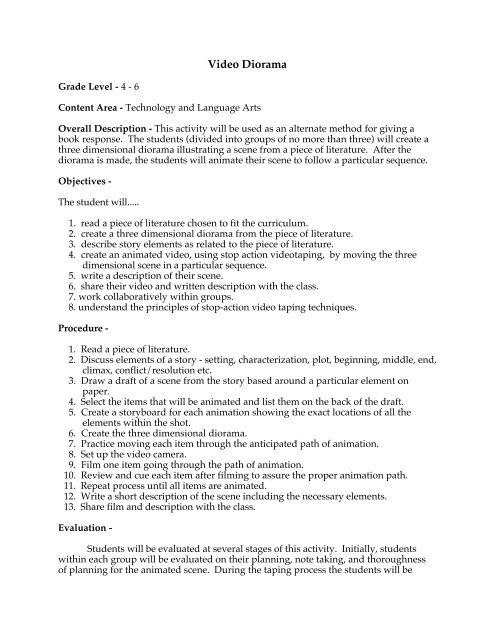Video Diorama
Video Diorama
Video Diorama
You also want an ePaper? Increase the reach of your titles
YUMPU automatically turns print PDFs into web optimized ePapers that Google loves.
Grade Level - 4 - 6<br />
<strong>Video</strong> <strong>Diorama</strong><br />
Content Area - Technology and Language Arts<br />
Overall Description - This activity will be used as an alternate method for giving a<br />
book response. The students (divided into groups of no more than three) will create a<br />
three dimensional diorama illustrating a scene from a piece of literature. After the<br />
diorama is made, the students will animate their scene to follow a particular sequence.<br />
Objectives -<br />
The student will.....<br />
1. read a piece of literature chosen to fit the curriculum.<br />
2. create a three dimensional diorama from the piece of literature.<br />
3. describe story elements as related to the piece of literature.<br />
4. create an animated video, using stop action videotaping, by moving the three<br />
dimensional scene in a particular sequence.<br />
5. write a description of their scene.<br />
6. share their video and written description with the class.<br />
7. work collaboratively within groups.<br />
8. understand the principles of stop-action video taping techniques.<br />
Procedure -<br />
1. Read a piece of literature.<br />
2. Discuss elements of a story - setting, characterization, plot, beginning, middle, end,<br />
climax, conflict/resolution etc.<br />
3. Draw a draft of a scene from the story based around a particular element on<br />
paper.<br />
4. Select the items that will be animated and list them on the back of the draft.<br />
5. Create a storyboard for each animation showing the exact locations of all the<br />
elements within the shot.<br />
6. Create the three dimensional diorama.<br />
7. Practice moving each item through the anticipated path of animation.<br />
8. Set up the video camera.<br />
9. Film one item going through the path of animation.<br />
10. Review and cue each item after filming to assure the proper animation path.<br />
11. Repeat process until all items are animated.<br />
12. Write a short description of the scene including the necessary elements.<br />
13. Share film and description with the class.<br />
Evaluation -<br />
Students will be evaluated at several stages of this activity. Initially, students<br />
within each group will be evaluated on their planning, note taking, and thoroughness<br />
of planning for the animated scene. During the taping process the students will be
evaluated on their attention to detail and the degree to which the animated scene<br />
relates to the particular tory element they are trying to portray. Finally, the students<br />
will be evaluated (both by the instructor and their peers) on the quality of the video<br />
taped animation.
















